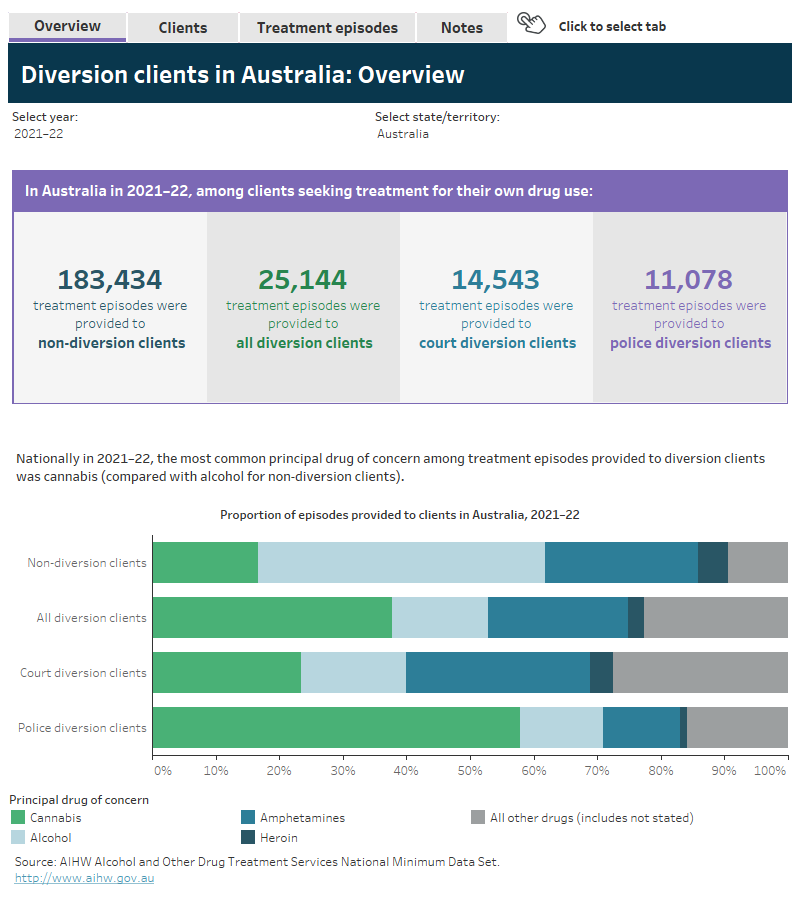Diversion programs in Australia Data
On this page:
What are drug diversion programs?
In Australia, drug diversion treatment programs (diversion programs) divert people who have been apprehended or sentenced for a minor drugs offence from the criminal justice system. Diversions often result in clients being referred to drug treatment agencies, including publicly funded AOD treatment agencies captured in Alcohol and Other Drug Treatment Services National Minimum Dataset (AODTS NMDS) data. Treatment services for clients referred via diversion programs range from short-term assessment (such as information or education sessions) to longer-term treatments (such as counselling or withdrawal management).
There are 2 key types of diversion programs in Australia that are captured in AODTS NMDS data:
- Police diversion occurs when an offence is first detected by a law enforcement officer. This typically applies for minor drug offences (for example, drug possession or use), often relating to cannabis. The offender may receive a caution or fine and will sometimes be required to attend mandatory drug assessment or education sessions.
- Court diversion occurs after a charge has been laid. It is usually applied for offences where criminal behaviour was related to drug use (for example, burglary or public order offence). Bail-based programs generally involve drug assessment and treatment, while pre– and post–sentence programs (such as drug courts) are aimed at repeat offenders and may involve more intensive treatment.
For more information on diversion programs, refer to the Key terminology and glossary.
Diversion has several objectives, including:
- Avoiding the negative labelling and stigma associated with criminal conduct and contact with the criminal justice system.
- Preventing further offending by minimising a person’s contact with, and progression through, the criminal justice system.
- Reducing the number of people reaching the courts and prisons, thereby lightening the heavy caseload of courts and reducing delays as well as in costs of court processes and incarceration.
- Reducing unnecessary social controls.
Providing appropriate interventions to those offenders who are in need of treatment or other services.
About the diversion client data visualisation
This interactive data visualisation is based on data from the AODTS NMDS about clients who are referred to treatment via police or court diversion programs. It includes all clients with a valid statistical linkage key (SLK) who received at least 1 treatment episode for their own drug use with diversion as the referral source in a given collection period (that is, financial year). In this visualisation:
- Diversion clients include all clients who were referred to treatment via a diversion program (police or court) in at least 1 treatment episode in the collection period. For example, where clients received more than 1 treatment episode in the same collection period, if at least 1 had a diversion referral source then they are counted as ‘Diversion clients’ for the purpose of this analysis.
- Non-diversion clients include all clients who did not receive any episodes with a diversion referral source in the collection period.
Police and court diversion clients counts are reported both separately and combined in this visualisation. The sum of clients for police and court diversion exceeds the total number of diversion clients reported due to overlap where, for example, clients received at least 2 treatment episodes with referrals from police and court diversion in the same collection period.
How do we count treatment episodes provided to diversion clients?
Standard AODTS NMDS reporting counts diversion treatment episodes as the total number of episodes in which the source of referral was listed as ‘diversion’. For this feature diversion report, treatment episodes are counted as follows:
- Treatment episodes provided to non-diversion clients include all treatment episodes provided to non-diversion clients in the collection period.
- Treatment episodes provided to diversion clients include all treatment episodes provided to diversion clients (police or court). Where diversion clients received multiple treatment episodes in the collection period, all episodes related to these clients are counted as ‘diversion treatment episodes’ regardless of the referral source. For example, if a client received 2 treatment episodes in 2021–22 and 1 of these listed ‘diversion’ as the referral source, both episodes are counted as diversion treatment episodes even if the second episode did not list diversion as the referral source.
Treatment episodes in this visualisation are only included for clients with a valid SLK. The total number of treatment episodes reported is lower here than in the standard AODTS NMDS report, where all treatment episodes are counted regardless of client SLK.
The interactive data dashboard provides an overview of treatment episodes provided to diversion clients in Australia in 2021–22.
A series of tiles show that, in 2021–22, 183,434 treatment episodes were provided to non-diversion clients, 25,144 episodes were provided to all diversion clients, 14,523 episodes were provided to court diversion clients and 11,078 episodes were provided to police diversion clients.
A stacked horizontal bar graph shows that alcohol was the most common principal drug of concern (PDOC) in treatment episodes provided to non-diversion clients (45.3% of episodes), while cannabis was the most common PDOC among episodes provided to all diversion clients (37.8% of episodes). The proportion of episodes with cannabis as the PDOC was higher for police diversion clients (57.9% of episodes) than court diversion clients (23.4%).
Filters allow the user to view data by year (2017–18 to 2021–22) and by state or territory. Navigation buttons allow the user to navigate between the following tabs: Overview, Clients and Treatment episodes.



